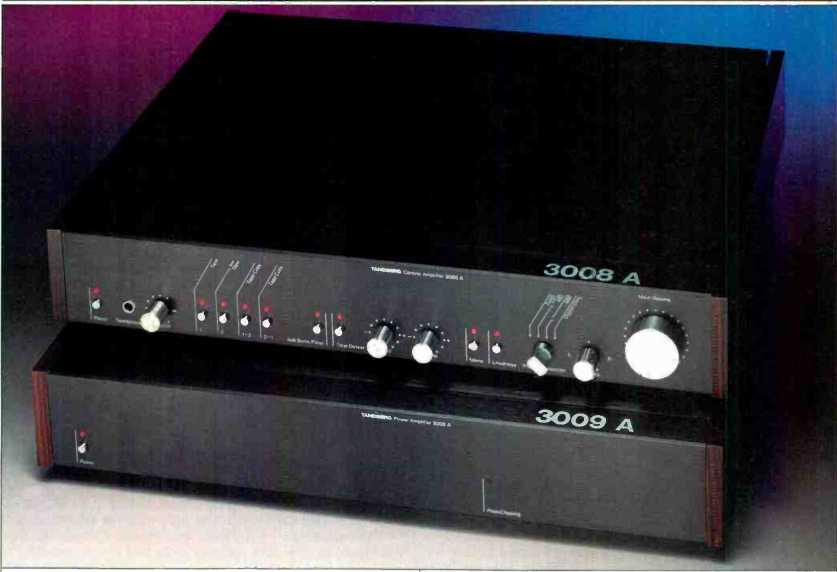
Manufacturer's Specifications:
Preamplifier:
Frequency Response: Line inputs, 20 Hz to 20 kHz, +0,-0.1 dB; 1.6 Hz to 250 kHz, ±3 dB. MM and MC phono inputs, RIAA 20 Hz to 20 kHz, ±0.2 dB.
Maximum Output: 10 V at clipping level.
THD (New IHF Standard): 0.004% for MM and MC inputs, 0.003% for "Digital Disc" inputs, 0.007% for line inputs.
Phono Input Sensitivity for 0.5 V Output at 1 kHz: 1.0 mV input for MM, 60 µV for MC.
Phono Input Overload: 290 mV for MM, 17 mV for MC.
S/N Ratio: 74 dB, A-weighted, for MM input; 78 dBA for MC input; 95 dBA for line inputs.
High-Level Sensitivity: 70 mV.
Phono Input Impedances: Selectable, 33/47/100 kilohms paralleled by 20/120/350 pF for MM cartridges; 150 ohms for MC cartridges.
Dimensions: 17 1/8 in. W x 3 1/4 in. H x 13 3/4 in. D (43.5 cm x 8.3 cm x 34.9 cm).
Weight: 39.9 lbs. (18.1 kg).
Price: $795.
Power Amplifier:
Power Output: 20 Hz to 20 kHz, 200 watts rms continuous into 8 ohms, 330 watts rms into 4 ohms, 456 watts rms into 2 ohms; 1,512 watts peak (pulse) power into 0.5 ohm.
Rated THD: Less than 0.05%, 1 to 2 ohms; less than 0.01%, 8 ohms.
Frequency Response: 0.07 Hz to 1.5 MHz, +0,-0.2 dB at 1 watt output.
S/N Ratio: 94 dB referred to 1 watt into 8 ohms, A-weighted; 117 dB referred to 200 watts into 8 ohms.
IM Distortion: Less than 0.05% at rated output.
Damping Factor: 250, wide-band.
Input Sensitivity: 150 mV for 1 watt output, 2.12 V for rated output.
Slew Rate: 250 V/µS. Rise-Time: 0.9 S.
Dimensions: 17 1/8 in. W x 3 1/4 in. H x 13 4 in. D (43.5 cm x 8.3 cm x 34.9 cm). Weight: 25 lbs. (11.3 kg). Price: $995.
Company Address: Labriola Court, Armonk, N.Y. 10504.
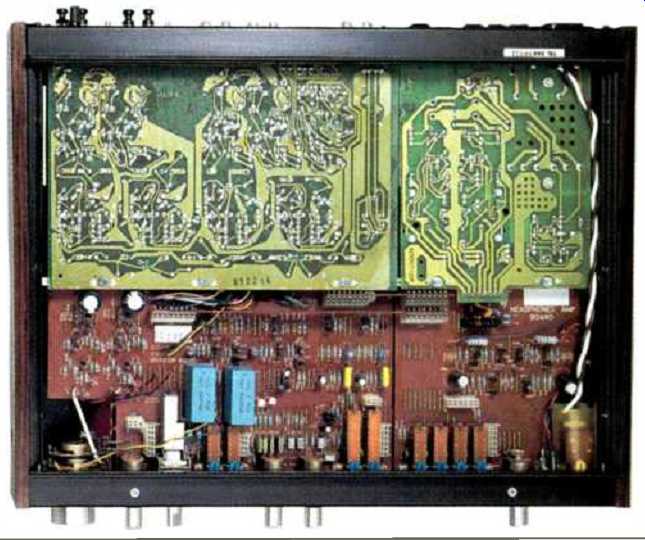
above: Preamp interior
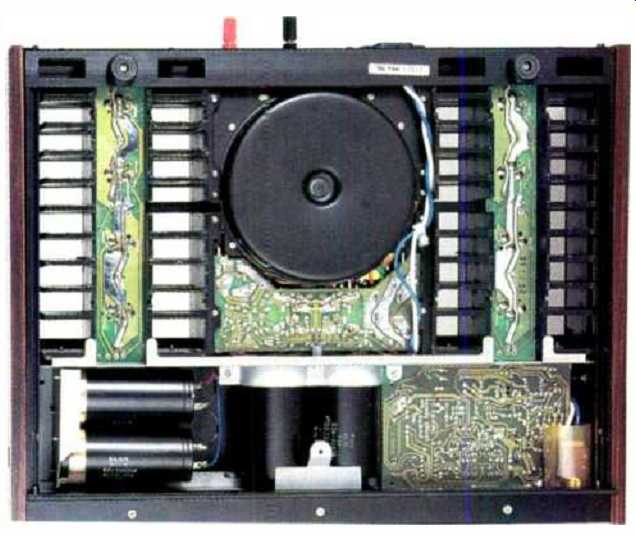
above: Amp, interior.
The 3008A preamplifier and 3009A power amplifier sit at the top of Tandberg's line of stereo products. These slim, attractive, Scandinavian-styled components represent the latest in Tandberg's thoughts about audio design. Their circuitry employs discrete components (no ICs), polyester capacitors (with low dielectric absorption) and metal-film resistors in the signal path, and minimal amounts of overall negative feedback-features believed by many audiophiles to be necessary for the best sonics.
The 3009A is rated to deliver 200 watts into 8 ohms and a staggering 1,512 watts (pulsed) into 0.5 ohm. The unit, an adaptation of the firm's 3006A stereo amplifier, is a monaural, high-current design that can deliver very high power into speaker loads, even ones with very low impedances. The low-impedance capability was intended for those who wish to drive several loudspeakers wired in parallel, or speaker systems with an intrinsically low load impedance such as the Apogee Scintilla. (The Scintilla can be configured as a 4- or a 1-ohm speaker, and many audiophiles feel it sounds better in the 1-ohm configuration.) The black chassis of the Tandberg amp and preamp are of rack width but lack mounting "ears." Each unit stands only 3 1/4 inches high, and their 13 3/4-inch chassis depth is convenient for placing these components on shelves or wall units. The 3009A weighs only 25 pounds, unusually light for a 200-watt mono amplifier.
Our samples came with rosewood side panels which allow two monaural amplifiers to be stacked for stereo use (single rosewood panels are also available). We have since learned that Tandberg does not recommend this arrangement for optimum performance, but we found it produced no ill effects.
Control Layouts
The preamp's front panel features a large number of controls. At the far left are the on/off switch and the headphone jack and its volume control. Next come four buttons which control monitoring and two-way dubbing facilities for two tape decks. Near the front panel's center are buttons for the subsonic filter and the tone-control defeat, the bass and treble tone controls, and buttons for stereo/mono and loudness-compensation switching. At the right is a rotary input selector, with positions for "Tuner," "MC" (moving-coil) and "MM" (moving-magnet) phono cartridges, and "Digital Disc." At the far right is a small balance control and a large, detented volume control.
On the preamp's rear panel are the signal, a.c., and ground connections. The high-level signal jacks include inputs and outputs for two tape decks, inputs for a tuner and a CD player, and the main preamp outputs. The phono stage has separate pairs of jacks for the MM and MC inputs.
Loading for MM cartridges is controlled by two toggles, one selecting load impedances of 100, 47 or 33 kilohms, and the other selecting load capacitances of 20, 120 or 350 pF. The back panel also features an unswitched a.c. output rated at 600 watts, and three switched outputs rated at a total of 300 watts. A fuse, a switchable 115- or 230-V a.c. input, and a detachable line cord make up the remainder of this highly functional back panel.
The amplifier's front panel contains only a power switch, an LED power-on pilot light just above the switch, and a second LED mounted at the front panel's right side, which serves as a clipping indicator. The rear panel holds nickel plated signal input connectors, and five-way speaker binding posts of somewhat nonstandard design. Like the preamp, the amp has a detachable line cord.
Mechanical Construction
The usual approach to audiophile-component construction is to make components that are as heavily built as their professional equivalents, but neater, and to pay little attention to styling beyond the functional. Tandberg took a different course. Instead of the usual, heavy chassis with bolted on panels, Tandberg built this amp and preamp around light but strong (and attractive) aluminum extrusions. The strongest ones, logically enough, make up the front and rear panels. Lighter extrusions for the sides serve as attachment points for the side covers and for a number of sheet-metal subchassis that hold internal components in place. These subchassis, and the liberally vented bottoms, are of thin, dull-finished sheet steel. The tops are made of two heavy, slotted extrusions which lock into place, covering the attachment screws. This technique minimizes the number of screw heads visible on the top and side cover panels, thus enhancing the components' appearance, but may lack the strength of a more "unitized" assembly. All chassis components are held together with sheet-metal screws rather than the machine screws which we prefer. While we would not recommend this construction for professional use (and abuse), we find it adequately strong for its intended home applications. The light chassis, dull-steel bottom and internal structures, and cost-effective fasteners make it clear that Tandberg favors external cosmetics over internal overbuilding; audiophiles who worship the innards of their components will not be as pleased. We prefer less slick, more purely functional styling, but all that's a matter of taste.
In the rear two-thirds of the amplifier chassis, vertical, chimney-type heat-sink castings flank and support the large toroidal transformer. The venting of the top and bottom leaves a number of open areas to act as flues for these heat radiators, making a fan unnecessary despite the amplifier's slim design.
The quality of the major circuit boards and the components on them is just what you'd expect for a product in this price range. The amplifier's boards are epoxy-glass, with component-designator screening and solder mask, but they lack the clean finish and solid mounting that is important to some enthusiasts. Most resistors are ordinary 5% types, but there are trimpots and 1% devices where needed for precision. The 3009A's capacitors include 85° C stand-up electrolytics, polypropylenes, and a huge 2.2-uF Wima MKP cap used for input coupling. Interconnection between boards is made via nylon modular plug/socket units with nickel-plated pins and insulation-displacement wire termination.
The amplifier's power supply uses a large toroidal transformer, which not only has a low enough profile to fit in the slim package, but radiates much less 60-Hz magnetic hum than conventional, E-I laminated transformers. When the mono 3009A amplifier was adapted from the stereo Model 3006A, the space vacated by the second channel's driver board was filled with two additional power-supply electrolytic capacitors. The resulting complement of four 15,000-µF, 80-V electrolytic capacitors stores the full-wave rectified output of the 3009A's transformer. This gives a very high energy storage of 123 joules.
The 3008A preamplifier refines the integration of mechanical structure, user controls, and circuit boards found in the companion power amplifier. Identical decorative and structural extrusions are used in both products, but they suit the preamplifier even better than they do the amplifier. Not only is the lightweight, screwed-together frame perfectly adequate for the preamplifier, but only one crosspiece is required to support the inner edges of the 3008A's four main circuit boards. The front edges of the forward p.c. boards are supported by the front-panel controls and switches. The rear edges of the other two boards have protruding tabs which fit into slots in the vertical, rear-panel boards. We prefer designs in which the circuit boards are firmly screwed down to spacers or chassis mounting bosses; even so, this construction is efficient and provides exceptional service access.
The preamp's circuit boards have clean and open layouts, solder mask, and component designators. The two front p.c. boards are made from what appears to be brown phenolic material. This material doesn't have the strength and crack resistance of the epoxy-glass used for the other two boards.
Component quality is mixed. Tandberg apparently opted for expensive parts only where they felt there would be sonic merit in doing so. Among the higher quality components are eight very large, 10-uF capacitors and four 4.7-µF capacitors, apparently made from carefully selected dielectric materials. There are many other board-mounted polypropylene and chip capacitors, along with 1% resistors. On the less expensive side, one can find eight exposed-track trimmers (subject to problems with dust if they ever need to be readjusted) and push-on modular connectors. Many board-to-board audio runs are made via twisted-pair leads or simply bundled parallel runs. This did not seem too promising for achieving low crosstalk, but our tests showed otherwise.
As with the amplifier, the 3008A's controls have a firm but lightweight action, without the solid, positive feel found in the controls on more expensive preamplifiers. The step-type volume control is an ordinary rotary pot, with a toothed wheel and spring to provide the detents. This action can be defeated easily if need be. All the rotary control elements appear to be the inexpensive, popular, and very satisfactory ones made by Alps.
Preamplifier Circuitry
The preamplifier utilizes two pairs of RIAA amplifiers for each channel. The moving-coil input goes into an MC input amplifier whose gain and noise performance are optimized for low-output, low-impedance moving-coil cartridges. The MM inputs on the rear panel go into MM phono amplifiers that have lower gain and whose inputs are optimized for MM cartridges. Both MM and MC input signals are applied first to flat pre-preamplifiers before being routed to a passive, high-frequency RIAA equalizer. The low-frequency portion of the RIAA equalization is provided by feedback around the second phono-amplifier stage. Input overload from pre equalized square waves, a common problem in pre-preamplifiers, is avoided here by relatively low gain and very high (±32 V) rail voltages. (Tandberg was wise to use discrete transistor circuitry; these voltages would not be possible using common low-noise integrated circuits.) To prevent d.c. offset, the phono preamp's output at the selector switch uses capacitive coupling, as opposed to the popular servo amplifier approach. Four large, rectangular, 4.7-uF polyester coupling capacitors are firmly mounted on the preamplifier's circuit board.
The discrete transistor circuits in the phono section and in the line output stage are very simple, using only five to seven bipolar devices per gain block. An unusual feature is the single-transistor emitter-follower unity-gain buffer used on all line inputs except CD. These buffers' low output impedance probably is the reason we did not find the crosstalk that the interior wiring led us to expect.
Amplifier Circuitry
As mentioned above, the 3009A design is a mono conversion of Tandberg's highly regarded 3006A stereo amplifier.
Like the 3006A, this amplifier uses MOS-FET output transistors. MOS-FETs have several advantages, including a region with a negative thermal characteristic. This means that their internal resistance rises as 'hey become hotter, which tends to turn them off. (Bipolar devices, on the other hand, have a positive thermal characteristic, which necessitates additional circuitry to make them thermally stable.) In addition, MOS-FETs tend to have greater bandwidth than bipolars, and can switch on and off at higher frequencies.
MOS-FETs may not be inherently superior to bipolar transistors, but every MOS-FET amplifier we have tested handles very high frequencies, particularly square waves, with much less strain than bipolar amplifiers do. MOS-FET amplifiers usually clip more cleanly, and mutual conduction is generally not evident until very high frequencies (around 100 kHz). MOS-FET amps run hotter at all levels and require higher rail voltages.
The eight MOS-FET output devices that made up the stereo 3006A's two channels are tied in parallel to make up the 3009A's single output. Paralleling the output stages doubles their current-delivery capacity, greatly enhancing their ability to drive low-impedance loads. Paralleling output stages can be done more easily with MOS-FET outputs than with bipolar transistors; paralleling two bipolar output stages would impose heavy current-delivery demands on the driver stage. MOS-FETs, on the other hand, require very little current compared to bipolar devices, even at high frequencies. A single driver stage, carried over from the 3006A, has adequate power to drive the 3009A's two paralleled MOSFET output stages.
The 3009A incorporates 28 discrete transistor devices and field-effect transistors (FETs) in the amplification channel, not to mention those found in the power supply, servo circuit and clipping indicator. The signal path begins as the input feeds a dual-complementary, single-ended FET input.
(It is not a differential input, the kind very commonly found in amp designs these days.) Next, the signal goes to four complementary gain and level-shift stages. These are connected like four independent cascaded amplifiers, each depending on local feedback only. The signal then goes to a driver with three emitter-follower stages, each with extremely low current gain. Associated with that triple emitter follower are a pair of transistors used to set output-stage bias. This group provides the drive for the paralleled output MOS-FETs (four up and four down) via individual 680-ohm resistors to their gates.
Tandberg's error-correction circuit is a bit unusual. The output signal is linked to the bases of two transistors. In our reading of the schematic, these two transistors form a bias setting circuit, where the output signal is amplified and applied to the drivers in such a way as to generate negative feedback around the unity-gain output stage. (To have negative feedback around a unity-gain stage requires amplification of the feedback signal itself.) Tandberg, however, describes the two-transistor circuit as a comparator which generates a feed-forward error-correction signal, because the correction signal can be greater than the output of the first emitter follower, and thus the entire circuit can have a negative output. A distortion-nulling pot at this point trims the compared gain for minimum distortion and, Tandberg says, for unity gain. Whether feedback or feed-forward is the method, the 3009A's ultra-low output impedance and distortion, plus its ringing on square waves when driving a capacitive load, indicate to us that some form of error correction is in use around the output stages. However one views Tandberg's actual signal-correction method, it functions very well, particularly at high frequencies.
The 3009A's circuitry eliminates d.c. offset by means of a large input-coupling capacitor. The circuit includes a servo amplifier by which the service technician can adjust a trim pot to null d.c. When fault conditions (including overdrive and short-circuits) are sensed, speaker relays open. These relays employ contacts coated with 24-karat gold. Because gold plating is usually very thin, it disappears after the relays open several times under full power. Coauthor Clark's experience in developing clean relay switching for comparators led him to conclude that gold plating is best applied to low-level circuits, where big arcs that vaporize gold plating don't occur.
The output stage is wired directly to the output terminals, without a conventional output-decoupling network. The main feature of the conventional network is a series inductor which, at supersonic frequencies, isolates the amp from highly capacitive loads which might cause it to oscillate.
This series inductor (r.f. choke) circuit can also affect the upper audio frequencies, causing a slight isolation at frequencies as low as 10 to 20 kHz, thus lowering the damping factor in this range.
Tandberg's design avoids the shortcomings of output-decoupling networks, but it is influenced by capacitive output loads despite the lack of overall negative feedback.
Since our tests, Tandberg has introduced a modification (now present in all production units) to limit this influence to the ringing we observed, and prevent oscillation without resorting to the more common inductive circuit. The modification places a series-connected resistor and capacitor in parallel across the outputs. This terminates the amplifier at supersonic frequencies, yet does not limit the unit's excellent damping factor.
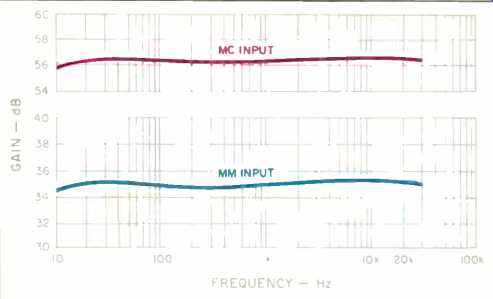
Fig. 1--RIAA response, 3008A preamplifier. Top curve is MC input with 100-ohm
load; bottom curve is MM input with 47-kilohm load.
Preamplifier Measurements
Measured from input to main output, using a standard IHF load, the left channel's phono gain was 52.6 dB for the MM input and 73.8 dB for the MC jack. IHF sensitivity, measured from input to main output, was 0.1 mV for the preamplifier's MC input, 1.2 mV for MM phono, and 17.4 mV for all auxiliary line-level inputs.
Signal-to-noise ratios were measured next. The A-weighted measurements included 80.5 dB for the MM phono input and 70.5 dB for the MC phono input-both very good.
Phono overload for the standard 1-kHz input signal was 330 mV at the MM input and 17 mV at the MC input.
Overload for the auxiliary stage, measured from auxiliary input to main output, was a high 12.0 V, in keeping with Tandberg's attempt to provide a high overload for the outputs of Compact Disc players. "Line in" input overload in a preamp is only of concern when the selected input is amplified before being applied to the volume control. With direct application to the volume control, the signal is attenuated before it can cause an overload. The 3008A, however, has buffer amplifiers and, if selected, an active subsonic filter ahead of the volume control.
Phono RIAA equalization error initially measured ± 1.0 dB, 20 Hz to 20 kHz, but this was for a very early production unit. Replacing two resistors brought our test unit up to par with current production, with an improvement in this measurement to ±0.3 dB for the MM input and ±0.2 dB for the MC input, 20 Hz to 20 kHz, as shown in Fig. 1.
Channel-to-channel crosstalk in the phono section was found to be greater than-49.5 dB in the MC phono section and-49.0 dB in the MM section, both from 20 Hz to 20 kHz. This is a respectable figure for any preamp.
The line amplifier section's THD + N was found to be less than 0.014%, 20 Hz to 20 kHz, at 10 V output using either a normal or IHF load. On the oscilloscope, the distortion appeared primarily as low-order harmonics and was fairly constant across the audio band.
Amplifier Measurements
The 3009A was first run for one hour at 33% of rated power (about 66.7 watts per channel) into 8-ohm loads with a 1-kHz test signal. The chassis top became warm, but the amplifier didn't thermally shut down.
Voltage gain was found to be 28.9 dB. This requires an input of 1.44 V for full power into an 8-ohm load. The IHF sensitivity for 1 watt into 8-ohm loads at 1 kHz was 102 mV. Power output from 20 Hz to 20 kHz for a variety of load conditions is shown in Table I. The amplifier easily meets and exceeds the manufacturer's specified continuous power ratings at 8, 4, and 2 ohms. Continuous power into 0.5 ohm is a very strong 684 watts, an outstanding figure.
Dynamic headroom measured 1.1 dB (45.2 V, 255.0 watts) relative to 200 watts rated power into 8 ohms. The 4-ohm IHF headroom was 1.3 dB (44.4 V, 449.0 watts). These figures indicate a power supply with tighter-than-usual voltage regulation.
Our standard test of peak output current utilizes a 20-mS pulse (repeated at a 0.5-S rate) driving one channel of the amplifier into a 0.1-ohm load. Under these conditions, the 3009A delivered 7.1 amperes rms (right channel), a low figure for instantaneous rms current delivery among high-powered amps on the market today. Yet, at 0.5 ohm, the Tandberg delivered a staggering 37 amperes rms of current, which is a record for amplifier current delivery on our test bench. Most amplifiers we have tested put more current into a short than any other load. The delivery of 37 amperes rms (52.3 peak amperes) into 0.5-ohm loads basically confirms Tandberg's claim that the 3009A has 55-ampere peak output capability. It is theoretically conceivable that the protection circuitry could mistake a highly reactive, low impedance load as a short and limit the amplifier's output.
This would be a most unusual condition, however, and we did not encounter it in practice.
Operating the amp at rated output power, the maximum total harmonic distortion plus noise (THD + N), 20 Hz to 20 kHz, measured 0.049% for 8-ohm loads (at 40.0 V/200 watts), 0.029% for 4-ohm loads (at 36.3 V/330 watts), and 0.033% for 2-ohm loads (at 30.0 V/450 watts). Measurements at lower levels all indicated lower distortion, as shown in Table II. The 3009A produces an exemplary 20-kHz, full-power square wave. The lack of an output network allows the 3009A to maintain a high damping factor at supersonic frequencies, resulting in great control of the rise-time and overshoot of the 20-kHz square wave. The low-frequency damping factor measured 264 for 8 ohms and remained at 101 up to 20 kHz for the wide-band damping factor. Figure 2 illustrates the 3009A's 20-kHz square-wave response at rated power, 200 watts per channel, into 8 ohms. Rise-time is less than 1µS. The slew rate is asymmetrical, 177 V/µS in the positive direction and 160 V/µS negative, as measured on a 50-MHz oscilloscope. IHF slew factor into 8 ohms was a very high 10.0 (200 kHz). Adding a 0.1-µF capacitor in parallel with the 8-ohm output load caused considerable ringing, as shown in Fig. 3. However, capacitors as large as 2.5 µF only lower the ringing frequency, with no significant increase in distortion of a sine-wave output at 20 kHz.
The 1-watt frequency response into 8 ohms shows the amplifier to be well within ±0.1 dB from 20 Hz to 20 kHz.
The -3 dB points are about 400 kHz at the high-frequency end and 0.17 Hz at the low end. Input impedance is somewhat frequency-dependent, measuring 105 kilohms at 1 kHz and 39 kilohms at 20 kHz.
The IHF signal-to-noise ratio, which is A-weighted noise referred to 1 watt output into 8 ohms, measured an excellent 91.9 dBA. Crosstalk measurements generally do not apply to monophonic amplifiers, but we measured the crosstalk possible when two Tandberg units were mounted together in the optional rosewood frame. Crosstalk versus frequency was measured by driving one amp and measuring the leakage into the other, with the unused input terminated by a 1kilohm resistor. Even with one amp stacked on top of the other, the separation between the two was greater than 99.6 dB from 20 Hz to 20 kHz!
Use and Listening Tests
Equipment used by coauthor Greenhill to evaluate the Tandberg 3008A preamp and 3009A amplifier included a Linn Sondek turntable with a Magnepan Unitrac 1 arm, Accuphase AC-2 moving-coil and Shure V15 Type V-MR cartridges, a Philips Compact Disc player, a Mark Levinson ML-7 reference preamp, and Mark Levinson ML-9, Onkyo M-510, Classé Audio DR-3 and Bryston 4B solid-state power amps. Apogee Scintilla, Snell Type A-III, and Jung/Randall-modified Dahlquist DO-10A loudspeakers were used.
Tandberg's recently developed speaker wire and interconnect cable were supplied to Greenhill for the listening evaluation; the cable employs a proprietary dielectric insulation material developed by Norwegian chemical and petroleum product manufacturers.
The 3009A amplifier's speaker terminals do not accommodate heavy audiophile speaker cables or many types of speaker-connector hardware. After some experimentation, we settled on single banana plugs, which made adequate electrical contact even though they could not be pushed in all the way (because each terminal post's inner well is a bit too shallow). Spacing between the terminals is too narrow for double bananas. We feel bare wires don't make optimal contact, either, because the ridge on the knurled plastic clamp that forces the wire against the terminal's metal base deforms before sufficient pressure is generated. Spade-lug wire terminators were tried, but the pressure on the one-sided contact still seemed low to us for the rated 55 peak amperes.
If one or more pairs of Tandberg 3009As are used in a system, they should be turned on in sequence rather than simultaneously. This is true for most high-power amplifiers that don't contain turn-on surge-limiting circuitry.
Subjectively, Clark was struck by the sexy Scandinavian styling of two 3009A amps stacked one atop the other with the rosewood side panels. He also admired the thermal cooling vents and the reworked back panel, which lent the product a sort of modified "hot rod" quality.
Clark auditioned these components in his home system, and in his special listening room whose design was based on a study by the International Electronics Commission (IEC). The amplifier was interfaced with a number of different kinds of equipment, including Fried Studio IV speakers.
Clark found the easy, sparkling sound matched his visual reactions to the product. He also found the 3008A preamp to have fast, detailed sonics that matched the amplifier's.
Other audio professionals visited Clark's listening room and drove a pair of 813B Urei monitors with the 3009As. They were very impressed by the amplifier's power, especially considering its small size, and said the 3009A was the most powerful-sounding amp they had yet heard driving these massive speakers!
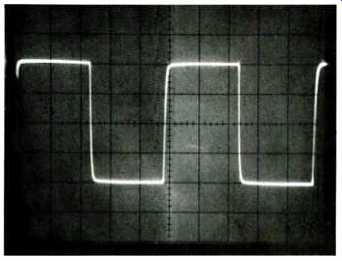
Fig. 2--Response of 3009A amplifier to a 20-kHz square wave, at 200 watts
into 8-ohm load. (Scales: Horizontal, 10 µS/div.; vertical, 20 V/div.)

Fig. 3--Same as Fig. 2, but showing effect of a 0.1-µF capacitor across
the load.
In Greenhill's evaluation, the two amplifiers were kept six feet apart, short speaker-cable runs were employed, and the units were gain-matched to a number of other fine amplifiers for open testing. Greenhill found the Tandberg amplifier's bass response seemed slightly less defined over his reference Snell Type A-III speakers. The Tandbergs could not deliver the high sound pressure levels of the higher rated (at 8 ohms) Onkyo M-510, nor did they deliver as much depth of imaging as two Classé Audio DR-3s. Yet the Tandbergs excelled in all other areas, showing remarkable sound-stage width and ability to separate singers and instruments in a three-dimensional field. This high definition may be attributable to the dual-mono design, with its absence of crosstalk. The preamp delivered the same spacious sonics, with midrange speed and detailing, while being free of midrange brightness.
The amps were then transported to another system, composed of Quad ESL-63 electrostatic loudspeakers, a Spectral DMC-10 (Gamma version) preamp, Krell KMA100 mono amplifiers, Monster Cable interconnects, and Randall speaker wire. The audiophile who had assembled this system found the Tandbergs' sound accurate, although the Krell amplifiers (which cost more than twice as much as the 3009A pair) just edged out the 3009As by playing with "greater air, more ambience and definition in the highs," whereas the Tandbergs produced "smoother highs with less definition." For him, the Tandberg amps represented an excellent value.
After living with the 3009A amplifiers for more than two months, Clark ran a series of controlled, double-blind listening tests. He made 16 identification attempts over a 11/2 hour listening session, using a Bryston 413. (dual-mono) amplifier for comparison. The results were 12 correct out of 16 trials, a statistically significant score. (We consider a score statistically significant when there is less than one chance in 20 of that score's being due to random guessing.) In the same room at a later time-and using the same test records, amplifiers, and order of presentation of test trials-- Clark tried to replicate this feat. During this second attempt, he achieved only seven correct identifications out of 16 trials, which we consider a statistically non-significant result.
Because all conditions were held the same for these two tests, he felt it reasonable to combine the test results for a total of 19 correct out of 32 trials, again a result we do not consider significant.
In an attempt to resolve the different outcomes of the two Clark tests, Greenhill ran additional controlled listening sessions with the 3009As. Over a two-week period, he carried out six more tests, consisting of 208 controlled, double-blind A/B/X comparisons, gain-matching the Tandbergs with two other expensive amplifiers-the Levinson ML-9 and the Onkyo M-510.
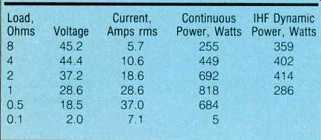
TABLE I--Maximum power output at 0.1% THD + N, 20 Hz to 20 kHz, 3009A amplifier.
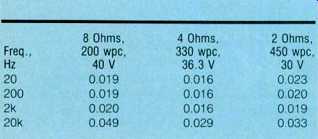
TABLE II--THD + N (%) at rated output, 3009A amplifier.
If one separately analyzes each of the different listening tests we conducted, involving a total of 240 controlled trials, one sees there were no statistically significant sonic differences found between the Tandberg and the other amplifiers, some of which cost twice as much as the 3009As. This finding suggests that increasing the number of listening tests over our usual 16 trials will not necessarily uncover a subtle sonic difference between amplifiers.
On the other hand, our subjective listening sessions left us highly impressed by the sonics of both Tandberg products. Over and over, we used both amp and preamp in our reviewing and for recreational music listening-which is what audio is about, after all! The 3008A preamplifier was more convenient to set up, use, and demonstrate than other, more expensive but perhaps less elaborate preamps. We particularly liked the preamp's headphone controls. As for the amplifier, two 3009As were lighter and easier to set up than many heavy audiophile stereo amplifiers, and were at least as powerful! The 3009A provided clean, effortless sound. Greenhill found over the months that these amplifiers continued to deliver outstanding transient speed and sound-stage width, with pinpoint instrumental placement, even though the results of the extensive double-blind tests revealed no distinctive sonic "fingerprint" for the amplifier which could be shown with statistical significance.
We feel very positive about these two new products from Tandberg. They are two of the best-designed, best-performing components we have tested for Audio. The 3008A preamplifier offers the prospective buyer a clever electronic design and outstanding functionality. The amplifier, which easily qualifies as a serious audiophile product, utilizes a paralleled MOS-FET output stage to deliver exceptional high-current performance, superb high-frequency response, and high power in a lightweight chassis at a reasonable price. We have only praise for the 3009A's sharp design and hot-rod performance.
-Laurence L. Greenhill and David L. Clark
(Source: Audio magazine, Jan. 1986)
Also see: Tandberg 3001 A FM Tuner (Mar. 1988)
Tandberg TCA 3018A Preamp and TPA 3026A Amp (Apr. 1987)
= = = =